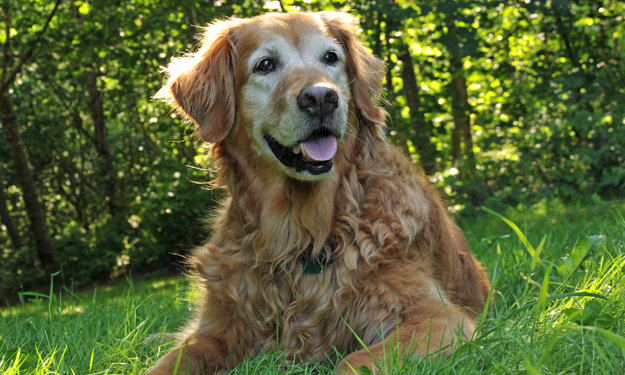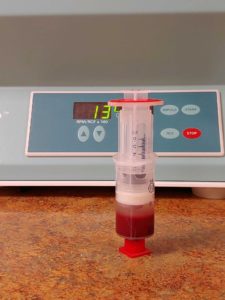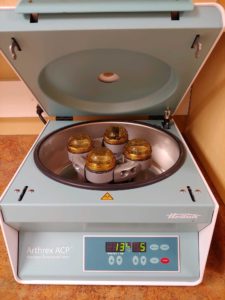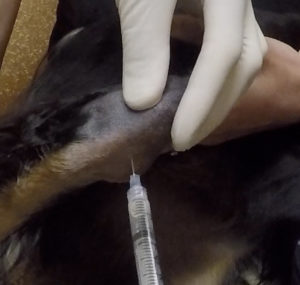Platelet-rich Plasma (PRP) in Veterinary Medicine

Written by Kristian Ash, BVMS, MRcVS, DACVS-SA
What is PRP?
Regenerative medicine is one of the newest fields of medicine and aims to prompt the body to heal itself by using the bodies own cells and substances to restore and repair damaged tissues. Although still in its infancy, regenerative medicine techniques are starting to permeate the veterinary field. When used in the orthopedic field, regenerative medical treatments (Stem cells, PRP, IRAP) are referred to as orthobiologics. The most widely used orthobiologic in small animal clinical practice is platelet-rich plasma.
Platelet-rich plasma (PRP) is an autogenous concentrate composed primarily of platelets and white blood cells. It is used as a biological supplement to facilitate delivery of vital growth factors required to stimulate healing. Although the utility of PRP is continually being expanded, its use in veterinary medicine is primarily associated with wounds and orthopedic applications.
A benefit of PRP is that it is not administered systemically, but rather applied directly to the site of tissue damage by intra-articular injection, peri-tendinous injection, or topical application.
Physiology/pharmacology
Platelets are among the first wave of cells that migrate to a site of injury following tissue trauma. Not only do they provide a critical hemostatic function, but they also release and provide growth factors required to stimulate the healing process. Platelet-derived growth factor (PDGF), transforming growth factor beta (TGF-β1 and TGF-β2), vascular endothelial growth factor (VEGF), basic fibroblastic growth factor, and epidermal growth factor (EGF) are all brought to the site of injury from the alpha granules of platelets.
Of particular importance, are the delivery of PDGF and TGF-β. PDGF stimulates angiogenesis, mitogenesis, and activation of macrophages. TGF-βaccelerates the production of collagen from fibroblasts.
PRP may also help to decrease inflammation by modulating interleukin-1 production.
Extraction
PRP is made by centrifugation of a whole blood sample. The resultant buffy coat and plasma are then extracted, and the leucocyte concentration further reduced.
The resultant concentrate has approximately 4-8 times the concentration of platelets than whole blood. During the preparation process, white blood cells are filtered out, as increased leukocyte concentrations have been linked to increased scar tissue formation, increased collagen degradation, and decreased tendon matrix production.
The platelet concentrate can then be used as a small volume liquid, or can be mixed with thrombin and calcium chloride to produce platelet-rich fibrin (PRF) gel.
Applications
Applications for PRP in small animal veterinary medicine are ever expanding. Currently, the most common applications appear to be in osteoarthritis (OA) management as well as tendon and ligament healing.
Intra-articular injections of PRP have been used in the treatment of osteoarthritis. Managing OA can be exceedingly frustrating due to the poor healing characteristics of articular cartilage. The avascular nature of articular cartilage severely limits the efficacy of systemic treatments. Local delivery of growth factors therefore is markedly advantageous to stimulate reparative processes on the joint surface. The evidence for PRP in osteoarthritis models in dogs is mounting. A randomized controlled clinical trial performed in 2013 showed subjective and kinetic improvement in gait 12 weeks following PRP injections for OA of a single joint. Likewise, a 2016 trial showed efficacy of multiple intra-articular injections of PRP following arthroscopic treatment for canine elbow dysplasia. Based on these studies, PRP injections following arthroscopic elbow surgery are one of the most common applications of PRP here at PEAK.
Another exciting area for the use of PRP is in aiding tendon and ligament repair. As with articular cartilage, the vascular supply to tendons and ligaments is typically poor and as such, limits their intrinsic healing capacity. Local administration of PRP to healing tendons and ligaments may help increase the likelihood of successful repair. A recent study in 2016 showed improved healing of the Achilles tendon when PRP was used as an adjunctive treatment to surgical repair. We now use PRP injections with all our Achilles tendon repairs and have found the results excellent.
Limitations
As with any therapeutic intervention, PRP does have its limitations and considerations. Its use in treating cranial cruciate disease, the most common ligament injury we face in small animal practice, is limited. A 2016 study compared dogs treated with PRP alone versus those treated with nothing. The results showed improved cartilage health, limb function, and range of motion using multiple PRP injections over a 6 month period, however the cranial cruciate ligament continued to degenerate and there was no difference in the radiographic appearance of OA regardless of whether or not PRP was administered. In an unrelated 2016 study where PRP was used alone to treat partial tears of the cranial cruciate ligament following arthroscopy, the results were encouraging with 30% of patients showing some improvement in gait, yet only 25% of patients had documented improvement in the health of the cranial cruciate ligament. These results suggest that PRP can be an effective therapy following surgical stabilization of the stifle to help in decreasing the effects of ongoing osteoarthritis, but that it is ineffective in the management of partial or complete cruciate ligament ruptures.
The risks associated with PRP injections are very low as it is a product of the patient’s own blood. The biggest risk associated with PRP is septic arthritis, an extraordinarily rare consequence of any intra-articular injection.
Conclusion
Platelet-rich plasma injections are a low risk, promising new regenerative therapy that may aid in the treatment of challenging orthopedic conditions in small animal veterinary medicine. The clinical use of PRP is increasing as the level of evidence for its efficacy continues to expand.